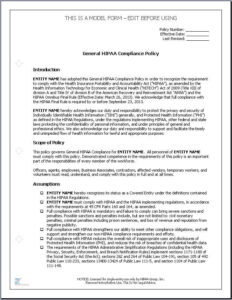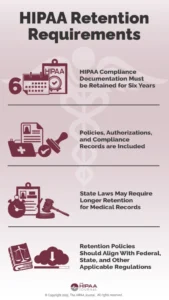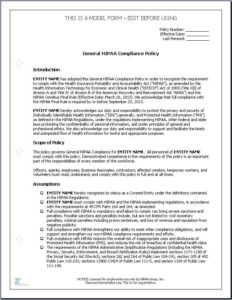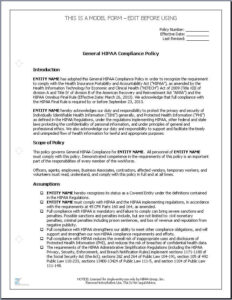Navigating the world of HIPAA compliance can feel like traversing a complex maze, right? You’re constantly juggling patient privacy, data security, and a whole host of regulations. One crucial aspect that often gets overlooked is ensuring that your HIPAA documentation is readily available. That’s where a robust HIPAA documentation availability policy template comes into play. Think of it as your organization’s roadmap for managing and accessing essential HIPAA documents, ensuring everyone knows where to find what they need when they need it.
A well-defined policy isn’t just about ticking a compliance box; it’s about fostering a culture of transparency and accountability within your organization. It outlines the procedures for storing, retrieving, updating, and even disposing of HIPAA-related documents. This helps to avoid potential fines, legal troubles, and, most importantly, protects your patients’ sensitive health information. Plus, it can save you precious time and resources by streamlining your documentation processes.
In this article, we’ll explore the importance of a HIPAA documentation availability policy template, what it should include, and how it can benefit your organization. We’ll also provide practical tips and insights to help you create a policy that is both effective and easy to implement. Let’s dive in and make HIPAA compliance a little less daunting, shall we?
Why You Need a Strong HIPAA Documentation Availability Policy
So, why is a HIPAA documentation availability policy so vital? Think of it this way: HIPAA regulations are like the rules of a game. You need to know the rules (the documentation) to play correctly (maintain compliance). A solid availability policy ensures everyone on your team has access to those rules when they need them. Without it, you’re essentially playing the game blindfolded, which is never a good strategy.
One of the key benefits is streamlined compliance. A clear policy outlines who is responsible for maintaining various HIPAA documents, where those documents are stored, and how to access them. This reduces confusion and delays, especially during audits or investigations. Imagine being able to quickly locate and provide the necessary documentation to demonstrate your compliance efforts – that’s the power of a well-defined policy.
Furthermore, a good policy promotes consistency. It ensures that all employees follow the same procedures when it comes to handling HIPAA-related documentation. This consistency minimizes errors, reduces the risk of data breaches, and fosters a culture of accountability. It also makes training new employees much easier, as they have a clear set of guidelines to follow.
Beyond compliance, a HIPAA documentation availability policy template can also improve operational efficiency. By centralizing and organizing your documentation, you can save time and resources that would otherwise be spent searching for misplaced or outdated documents. This can free up your staff to focus on more important tasks, such as patient care.
Finally, consider the impact on patient trust. When patients know that your organization takes their privacy seriously and has robust procedures in place to protect their information, they are more likely to trust you with their care. A clear and accessible HIPAA documentation availability policy demonstrates your commitment to protecting patient privacy and building a strong foundation of trust.
Key Elements of a Comprehensive Policy
What exactly should your HIPAA documentation availability policy template include? It’s more than just a list of documents; it’s a comprehensive guide to managing your HIPAA documentation effectively. First and foremost, the policy should clearly define the scope, outlining which documents are covered and who is responsible for each aspect of the policy. This includes identifying roles such as the Privacy Officer and Security Officer, and their specific responsibilities related to documentation.
Next, specify the types of documents covered. This might include: Notice of Privacy Practices, Business Associate Agreements, Risk Assessments, Training Records, and Incident Response Plans. For each type of document, clearly state its purpose, how it should be stored (electronically or physically), and how long it should be retained. Be sure to align your retention periods with HIPAA requirements and any applicable state laws.
Accessibility is key. Your policy should detail how authorized personnel can access the documentation. This might involve providing login credentials to a secure server, establishing a process for requesting physical documents, or granting access to specific sections of your electronic health record system. Ensure that access controls are in place to prevent unauthorized access.
Version control is also crucial. Your policy should outline how to track changes to documents and ensure that everyone is using the most up-to-date version. This might involve using a numbering system, date stamping, or a dedicated document management system. Regularly review and update your policy to reflect changes in HIPAA regulations or your organization’s practices.
Finally, don’t forget about disposal. Your policy should address how to securely dispose of HIPAA-related documents when they are no longer needed. This might involve shredding physical documents, securely wiping electronic data, or using a certified disposal service. Proper disposal is essential to prevent unauthorized access to protected health information.
A well crafted hipaa documentation availability policy template will help ensure your organization adheres to the standards set by HIPAA.
In the end, having readily available HIPAA documentation doesn’t need to feel daunting. By taking the time to craft a robust hipaa documentation availability policy template, your organization will be well positioned to demonstrate compliance and safeguard sensitive patient information.
With the right tools and processes in place, you can create a culture of privacy and security that benefits both your organization and your patients.



